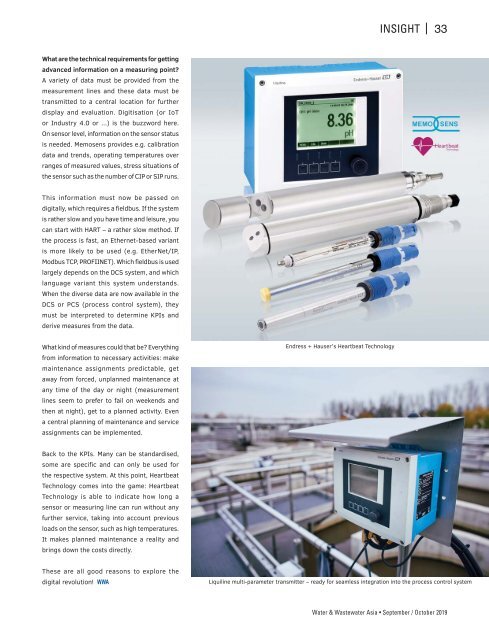Water & Wastewater Asia September/October 2019
Water & Wastewater Asia is an expert source of industry information, cementing its position as an indispensable tool for trade professionals in the water and wastewater industry. As the most reliable publication in the region, industry experts turn this premium journal for credible journalism and exclusive insight provided by fellow industry professionals. Water & Wastewater Asia incorporates the official newsletter of the Singapore Water Association (SWA).
Water & Wastewater Asia is an expert source of industry information, cementing its position as an indispensable tool for trade professionals in the water and wastewater industry. As the most reliable publication in the region, industry experts turn this premium journal for credible journalism and exclusive insight provided by fellow industry professionals. Water & Wastewater Asia incorporates the official newsletter of the Singapore Water Association (SWA).
- No tags were found...
You also want an ePaper? Increase the reach of your titles
YUMPU automatically turns print PDFs into web optimized ePapers that Google loves.
INSIGHT | 33<br />
What are the technical requirements for getting<br />
advanced information on a measuring point?<br />
A variety of data must be provided from the<br />
measurement lines and these data must be<br />
transmitted to a central location for further<br />
display and evaluation. Digitisation (or IoT<br />
or Industry 4.0 or ...) is the buzzword here.<br />
On sensor level, information on the sensor status<br />
is needed. Memosens provides e.g. calibration<br />
data and trends, operating temperatures over<br />
ranges of measured values, stress situations of<br />
the sensor such as the number of CIP or SIP runs.<br />
This information must now be passed on<br />
digitally, which requires a fieldbus. If the system<br />
is rather slow and you have time and leisure, you<br />
can start with HART – a rather slow method. If<br />
the process is fast, an Ethernet-based variant<br />
is more likely to be used (e.g. EtherNet/IP,<br />
Modbus TCP, PROFIINET). Which fieldbus is used<br />
largely depends on the DCS system, and which<br />
language variant this system understands.<br />
When the diverse data are now available in the<br />
DCS or PCS (process control system), they<br />
must be interpreted to determine KPIs and<br />
derive measures from the data.<br />
What kind of measures could that be? Everything<br />
from information to necessary activities: make<br />
maintenance assignments predictable, get<br />
away from forced, unplanned maintenance at<br />
any time of the day or night (measurement<br />
lines seem to prefer to fail on weekends and<br />
then at night), get to a planned activity. Even<br />
a central planning of maintenance and service<br />
assignments can be implemented.<br />
Endress + Hauser’s Heartbeat Technology<br />
Back to the KPIs. Many can be standardised,<br />
some are specific and can only be used for<br />
the respective system. At this point, Heartbeat<br />
Technology comes into the game: Heartbeat<br />
Technology is able to indicate how long a<br />
sensor or measuring line can run without any<br />
further service, taking into account previous<br />
loads on the sensor, such as high temperatures.<br />
It makes planned maintenance a reality and<br />
brings down the costs directly.<br />
These are all good reasons to explore the<br />
digital revolution! WWA<br />
Liquiline multi-parameter transmitter – ready for seamless integration into the process control system<br />
<strong>Water</strong> & <strong>Wastewater</strong> <strong>Asia</strong> • <strong>September</strong> / <strong>October</strong> <strong>2019</strong>


















